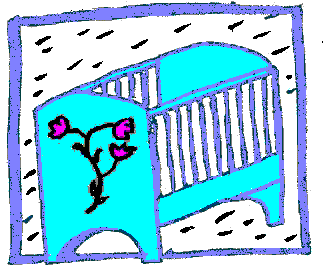
For infants under 12 months of age, follow these practices to reduce the risk of SIDS (sudden infant death syndrome) and prevent suffocation:
Drawing of a Crib
Place baby on his/her back in a crib with a firm, tight-fitting mattress.
Do not put pillows, quilts, comforters, sheepskins, pillow-like bumper pads or pillow-like stuffed toys in the crib.
Consider using a sleeper instead of a blanket.
If you do use a blanket, place baby with feet to foot of the crib. Tuck a thin blanket around the crib mattress, covering baby only as high as his/her chest.
Use only a fitted bottom sheet specifically made for crib use.
Check Your Crib for Safety
There should be:
A firm, tight-fitting mattress so a baby cannot get trapped between the mattress and the crib.
No missing, loose, broken or improperly installed screws, brackets or other hardware on the crib or mattress support.
No more than 2 3/8 inches (about the width of a soda can) between crib slats so a baby's body cannot fit through the slats; no missing or cracked slats.
No corner posts over 1/16th inch high so a baby's clothing cannot catch.
No cutouts in the headboard or foot board so a baby's head cannot get trapped.
Cribs that are incorrectly assembled, have missing, loose or broken hardware or broken slats can result in entrapment or suffocation deaths. Infants can become stranguled when their head and neck become entrapped in gaps created by missing, loose or broken hardware or broken slats.
For mesh-sided cribs or playpens, look for:
Mesh less than 1/4 inch in size, smaller than the tiny buttons on a baby's clothing.
Mesh with no tears, holes or loose threads that could entangle a baby.
Mesh securely attached to top rail and floor plate.
Top rail cover with no tears or holes.
If staples are used, they are not missing, loose or exposed.

